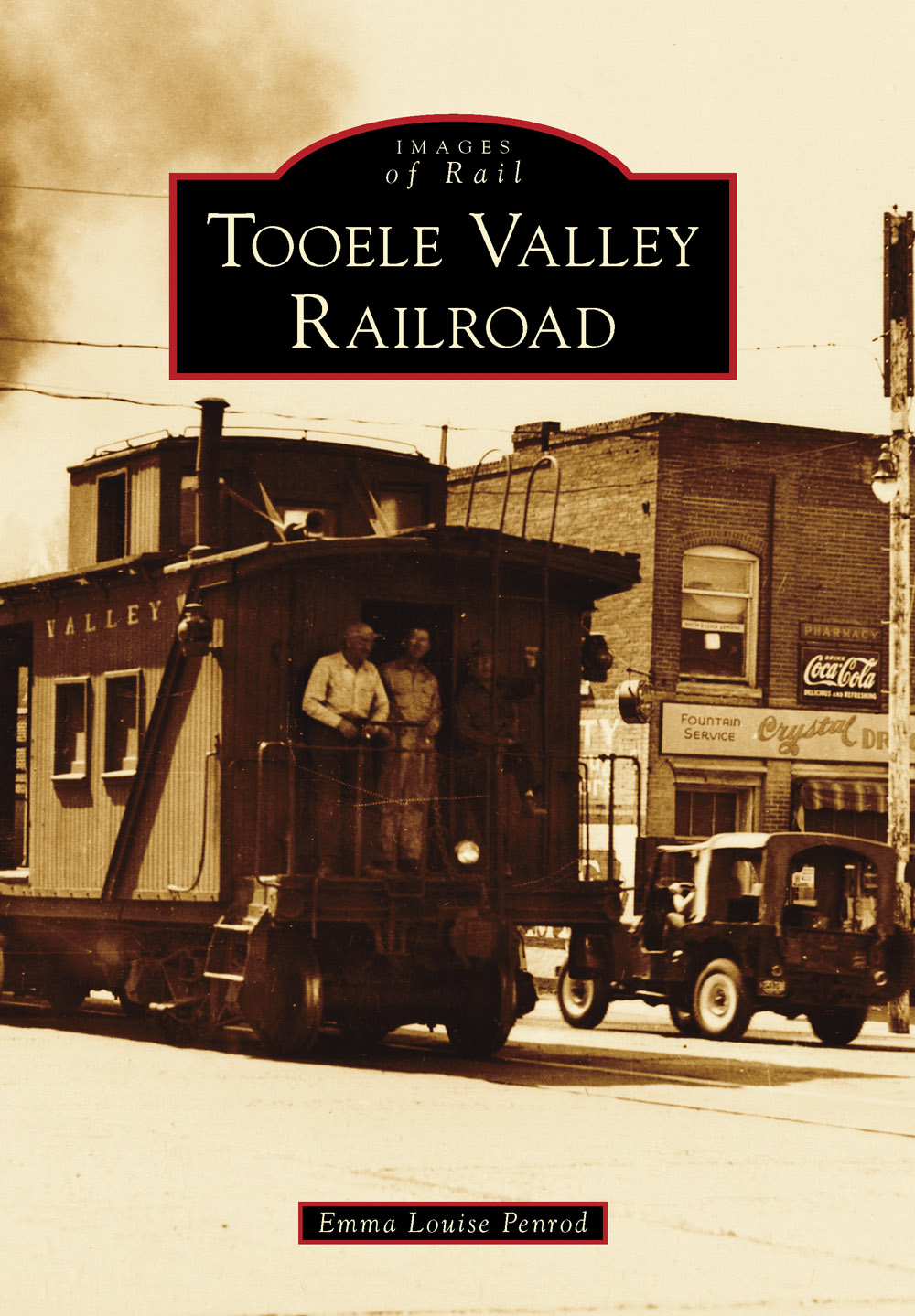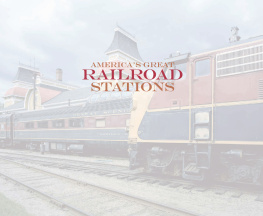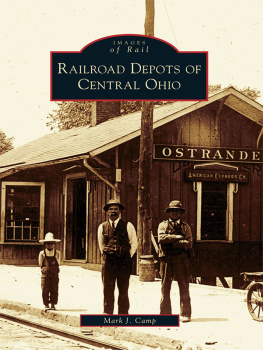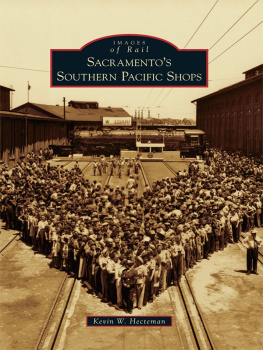
IMAGES
of Rail
TOOELE VALLEY
RAILROAD
ON THE COVER: In this iconic photograph from 1951, the Tooele Valley Railroad proceeds through the intersection of Vine and Main Streets in signature style: caboose first, engine pushing from behind. A horn on the caboose warned motorists of the approaching train. The buildings in the background still stand, though the intersection now has a traffic light instead of a train. (Courtesy of the Utah State Historical Society.)
IMAGES
of Rail
TOOELE VALLEY
RAILROAD
Emma Louise Penrod

Copyright 2013 by Emma Louise Penrod
ISBN 978-1-4671-3026-4
Ebook ISBN 9781439644058
Published by Arcadia Publishing
Charleston, South Carolina
Library of Congress Control Number: 2013946960
For all general information, please contact Arcadia Publishing:
Telephone 843-853-2070
Fax 843-853-0044
E-mail
For customer service and orders:
Toll-Free 1-888-313-2665
Visit us on the Internet at www.arcadiapublishing.com
For Jeff Barrus, the mentor who thought I could write a book. Looks like you were right.
CONTENTS
ACKNOWLEDGMENTS
History does not happen in a vacuum, and so I owe my ability to write this book to those who recorded and preserved the memory of the Tooele Valley Railroad. I am especially indebted to Jean Mogus, the current caretaker of the Tooele Valley Railroad Museum. Without her, this book would not have been possible. Gary Bevan also assisted us in collecting and identifying many of the photographs compiled in this book.
I also owe thanks to Tim Booth and James Bevan, with the Sons of Utah Pioneers, and to David Bern, the editor of the Tooele Transcript-Bulletin, for assisting me with my research.
Additionally, I am indebted to a great number of local historians who I never had the privilege to meet in person: Claude Atkin, Larry Deppe, Don Lee, and numerous others whose names unfortunately are not so frequently mentioned by the historical record, though they are no less important. I am especially grateful to all those who served on the original board that oversaw the creation of the Tooele Valley Railroad Museum. Without them, the vast majority of the railroads history would be lost today.
On the writing side of things, I owe special thanks to Brigham Young University for providing the creative works and research grant that made the creation of this book possible, and to Quint Randle, my faculty mentor, for keeping me on track throughout the process.
Last but not least, my editor at Arcadia, Jeff Ruetsche, deserves my gratitude for his unending patience in the face of numerous setbacks.
To all those family members, friends, fellow writers and historians, and readers who continue to support me: thank you. I hope the work I produce lives up to your faith in me.
INTRODUCTION
Stories about the Tooele Valley Railroad begin with its sister company, International Smelting. Utah Consolidated Mining, a conglomerate of mines pursuing wealth in the ore-laden Oquirrh Mountains, founded these sibling companies on the same day in 1908. For the mines, this was a matter of strict self-interest: smoke litigation in the Salt Lake Valley had cost the company its primary smelter. To turn a profit, the mines needed an immediate, cost-effective smelting solution.
While seeking an escape from the mounting tide of litigation that came with Utahs agrarian and urban centers, the mining executives discovered Tooele. This desert town, settled in a choice canyon on the western slopes of the Oquirrhs, presented Utah Consolidated with exactly the location it desired. Some 32 miles of scrubby wasteland, a salty lake, and the Oquirrh Mountains separated Tooele from the majority of nearby population centers. But industrialization had not left the town untouched. Mining booms had swelled nearby communities, such as Mercur, to populations near 10,000 in the recent past. The modern conveniences that came with a wealth of silver and goldelectricity, communications, and railroadsremained in place next door. Most importantly, vacant land in Pine Canyon could be found just opposite Utah Consolidateds mines in Bingham Canyon. Several mountain peaks stood in the way, but this obstacle seemed readily surmountable when compared to the costly pollution controls Salt Lake City now required.
Utah Consolidated found Tooele in something of an adolescent statea developing city of 1,200 at odds with itself. Mormon pioneers originally settled the valley in 1849, hoping to establish a self-sustaining agricultural community after the pattern of older Mormon colonies. But the areas soil proved too saline and the climate too dry for substantial crop production. Ranching became the industry of choice, but the populations limited success with its herds sustained little growth and left locals impoverished. Mining came to the valley in 1864 thanks to prospecting by the US army, but Tooele Citys Mormon majority initially rejected this development. By 1900, with the population divided by political and economic ideals, a perpetual identity crisis embroiled the community.
The tipping point came in 1908. After fighting judicial law in Salt Lake City for two years, seeking peace with lifelong competitors, and attempting to pacify litigious farmers with out-of-court financial settlements, Utah Consolidated ran out of alternatives. Company administrators scrambled to set up shop in Pine Canyon, knowing that every day of construction meant decreased productivity and lost profit. They still faced a number of problems not solved by the Pine Canyon location, including the absence of an obvious route for transporting ores to the new smelter. The nearest railroad station, called the Tooele or Warner station, serviced the Western Pacific, the Rio Grande Western, and the Union Pacific, but it was about six miles southwest of the smelter site. Utah Consolidated solved this problem with the creation of the Tooele Valley Railway.
The mines company conceived a short-line railroad that was essentially the shortest distance between two points: the International smelter and the station at Warner. The line spanned 6.235 miles, beginning at Warner, turning east to follow Vine Street through downtown Tooele, then angling gradually northward to meet the International rail yard. A railroad depot constructed at 35 North Broadwaythe intersection of Vine Street and Broadwaywould serve as a third station and as the Tooele Valley Railways company headquarters.
What political wrangling occurred in the fall of 1908 remains untold, but Utah Consolidated procured a right-of-way down the middle of Vine Street, one of the busiest roads in town, in relatively short order. In November, a little over a month after Utah Consolidated made the decision to move smelting operations to Pine Canyon, it incorporated two spinoff companies: the International Smelting Company, which later came to be known as International Smelting and Refining; and the Tooele Valley Railway Company, which many locals call the Tooele Valley Railroad, though it conducted official business under the railway name.
One final barrier stood between Utah Consolidated and the realization of its plans: Tooeles population. For the company to maintain its ambitious construction schedule, it planned to hire 600 workers at the smelter, 70 for the railroad, and another 200 to build a 20,000-foot-long aerial tram that would connect International directly to the mines in Bingham. The three projects could have employed 72 percent of the entire population living in Tooele City at the time.
Next page









